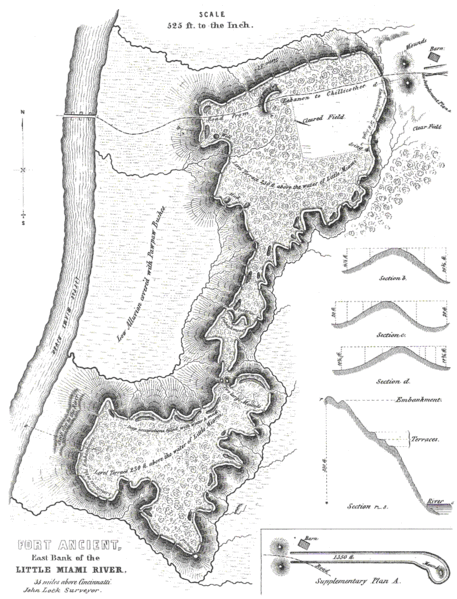Fort Ancient
Location: Lebanon, Ohio
Description: Per Wikipedia:
“Fort Ancient is a collection of Native American earthworks located in Washington Township, Warren County, Ohio, along the eastern shore of the Little Miami River about seven miles (11 km) southeast of Lebanon on State Route 350. The site is the largest prehistoric hilltop enclosure in the United States with three and one-half miles (18,000 ft) of walls in a 100-acre (0.40 km2) complex. Built by the Hopewell peoples, who lived in the area from the 1st century BC to the 6th century AD, the site is situated on a wooded bluff 270 feet (82 m) above the Little Miami.”
“The Fort Ancient earthworks were built in three stages over an estimated 400-year period. The shoulder blades of deer, split elk antlers, clam shell hoes, and digging sticks were used to loosen the dirt, and baskets holding 35 to 40 pounds were used to carry and distribute it. Archaeologists estimate the total volume of earth in the walls at 553,000 cubic yards (423,000 m3).”
“The site was visited and surveyed in by John Lock in 1843. In Edwin Hamilton Davis and Ephraim George Squier’s Ancient Monuments of the Mississippi Valley, they described Fort Ancient as ‘one of the most extensive, if not the most extensive, work…in the entire West’, regarding its size.” [47]
Ancient Monuments of the Mississippi Valley states the following:
“Upon the steep slope of the hill, at the point where it approaches nearest to the river, are distinctly traceable three parallel terraces, which were not represented in the original map, but which are indicated here. It is not impossible that they are natural, and were formed by successive slips or slides of earth, a feature not uncommon at the West. They nevertheless, from their great regularity, appear to be artificial, and are so regarded by most persons. A very fine view of the valley, in both directions, is commanded from them; though, perhaps, no better than may be obtained from the brow of the hill along which the embankment runs. It has been suggested that they were designed as stations, from which to annoy the enemy passing in boats or canoes along the river.”
“There are over seventy gateways or interruptions in the embankment, at irregular intervals along its line. For reasons heretofore given, it is difficult to believe they were all designed as places of ingress or egress. We can only account for their number, upon the hypothesis that they are places once occupied by block-houses or bastions composed of timber, and which have long since decayed. These openings appear to have been originally about ten or fifteen feet in width.”
“This work, it will be seen, consists of two grand divisions, the passage between which is long and narrow. Across this neck is carried a wall of the ordinary dimensions, as if to prevent the further progress of an enemy, in the event of either of the principal divisions being carried, – a feature which, while it goes to establish the military origin of the work, at the same time evinces the skill and foresight of the builders. This foresight is further shown, in so managing the excavations necessary for the erection of the walls, as to form numerous large reservoirs; sufficient, in connection with the springs originating within the work, to supply with water any population which might here make a final stand before an invader. Even in the absence of these sources, surrounded as the work is on every hand by streams, it would be easy, in face of the most formidable investment, to procedure an adequate supply.”
“A review of this magnificent monument cannot fail to impress us with admiration of the skill which selected, and the industry which secured this position. Under a military system, such as we fell warranted in ascribing to the people by whom this work was constructed, it must have been impregnable. In every point of view, it is certainly one of the most interesting remains of antiquity which the continent affords.” [48]
The Book of Mormon states:
Alma 21:149-150 – “149 And now it came to pass, in the eleventh month of the nineteenth year, on the tenth day of the month, the armies of the Lamanites were seen approaching towards the land of Ammonihah. 150 And behold, the city had been rebuilt, and Moroni had stationed an army by the borders of the city, and they had cast up dirt round about, to shield them from the arrows and the stones of the Lamanites: for behold, they fought with stones, and with arrows.”
Alma 22:1-3 – “1 And now it came to pass that Moroni did not stop making preparations for war, or to defend themselves against the Lamanites; for he caused that his armies should commence in the commencement of the twentieth year of the reign of the Judges, that they should commence in digging up heaps of earth round about all the cities, throughout all the land which was possessed by the Nephites; 2 And upon the top of these ridges of earth he caused that there should be timbers; yea, works of timbers built up to the height of a man, round about the cities. 3 And he caused that upon those works of timbers, there should be a frame of pickets built upon the timbers, round about; and they were strong and high; and he caused towers to be erected that overlooked those works of pickets;”
Alma 24:54-55 – “54 And Teancum, by the orders of Moroni, caused that they should commence laboring in digging a ditch round about the land, or the city Bountiful; 55 And he caused that they should build a breastwork of timbers upon the inner bank of the ditch; and they cast up dirt out of the ditch against the breastwork of timbers;”

